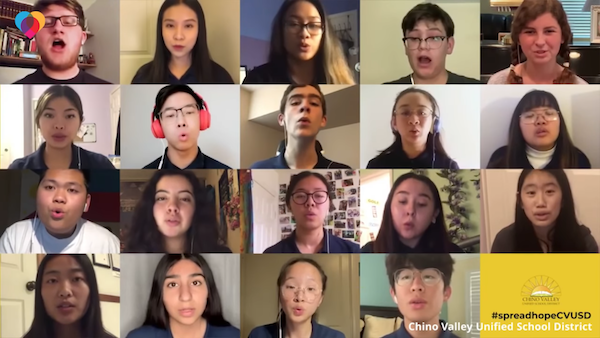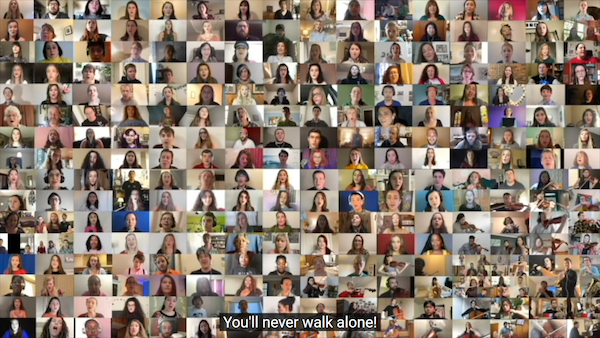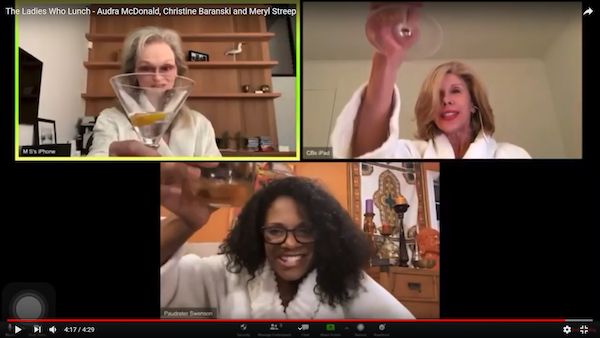From PiP to Zoom: A Brief History of Screen-Splitting

This arrangement of stacking the screen with five heads across by two heads down is called a decabox. In 2008, when CNBC started using this visual technique, widescreens were finally taking over U.S. households. With the geometry of 16:9 displays eclipsing the 4:3 standard, and high-definition obsoleting the low-res images of the previous century, programmers were free to devise new ways to partition screen real estate.
The decabox came along just in time to educate the public about the 2008 financial crisis. As Jon Stewart on The Daily Show quipped: "What if eight pundits aren’t enough? What if the enormity of this economic collapse is so huge that even eight of the financial industry's smallest-headed people can't figure it out?"
Screen splitting has a long history, but picture-in-picture was de rigueur in the fifties and sixties. George Burns spied on Gracie’s antics from a closed-circuit TV in his man cave. Edward R. Murrow interviewed remote guests on Person to Person. You’d think that Chet Huntley and David Brinkley elevated screen sharing as one said goodnight from New York and the other from Washington D.C., but in fact they each typically filled the entire screen with a technician switching serially between them. The game show, Hollywood Squares, split the screen nine ways, but the celebrity contestants occupied actual boxes constructed on a stage.
Then, in the eighties an actress (Heather Locklear) so impressed with her Fabergé shampoo, proclaimed: "You'll tell two friends. (split screen) And they'll tell two friends (quad screen). And so on. (16 boxes) And so on. (24 boxes) And so on."
Besides being an analog-age notion of viral marketing, the commercial's use of divvying up the screen into ever smaller boxes was dead-on regarding the shape of things to come. Although, back then, by the time you lost count of the number of friends learning about Fabergé shampoo, you couldn't see much detail in each of those tiny boxes. The TV was too small, and high definition was decades away.

I’m not saying you can draw a straight line between the calamity of split ends and the current pandemic, but on screens, at least, you can clearly see the excess of little boxes. Take the high schoolers from the Chino Valley Unified School District singing “Somewhere Over the Rainbow.” The school district’s annual Choral Festival was canceled, so the students all sang their individual a cappella portions in their homes. The result was a 20-box recital or double decabox. But why stop there?

By now, you’ve probably surmised that these virtual concerts have turned into schemes vying for Guinness World Records recognition. Most Virtual Heads Singing Together is a ridiculous category for sure, but no less so than Largest Attendance for a Movie Screening or Longest Screen Kiss—which are actual categories.
When it comes to parceling up the screen, there’s a major difference between entertainment versus news and commentary. That, of course, would be sound. In the former case, it’s okay for multiple audio sources merging to make music. In the latter, you want just one head talking at a time (unless, of course, you’re a cable executive who believes heads yelling over one another begets ratings).

What is lost in a mega cluster of shriveled boxes is intimacy—the kind you get from live theater or in a cozy jazz club. Just because a virtual concert can technically fit hundreds of pinheads on the screen at once doesn’t make it art. The sensation may be cool the first time you see video windows reduced to postage stamps. But by the tenth time, the effect is likely to provoke, at best, indifference. The hottest video is when you can feel the emotions of those you’re watching spilling out of the screen. Such intimacy is impossible when the display is cut up, diced and processed ad nauseam.
Take Zoom, the cloud-based video conferencing tool that in 2020 became synonymous with virtual meetings. Designed for remote office use and distance learning, the app was not intended for hundreds of would-be stars leaning into their webcams at once.
Perhaps that’s why the most compelling Zoom presentation I’ve enjoyed during these days of home confinement is “The Ladies Who Lunch,” which relied on a screen split just three ways. The song, a highlight from the musical Company, was performed by Meryl Streep, Christine Baranski and Audra McDonald in bathrobes from their homes as part of a 90th birthday salute to Stephen Sondheim, who wrote the show’s music and lyrics. All it took to transport the audience to the Elysium of Rapture were the real-time performances of three pros. I dare anyone to watch it and not tear up.













































